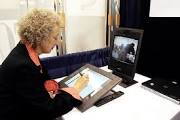This is the first in a series of blog entries about CHI 2014 that recently took place in Toronto. The ACM CHI Conference on Human Factors in Computing Systems is the premier international conference of Human-Computer Interaction.
On science fiction, comic books, fantasy, and their ability to drive innovation
“Margaret Atwood is a giant of modern literature who refuses to rest on her laurels (CHI 2014 website)” Her “speculative fiction” books, such as The Handmaid’s Tale, The Blind Assassin, and Oryx and Crake blur any lines separating literature from science fiction. Therefore, it may not be too surprising that her delightful Keynote speech to CHI 2014 centered on robots, both imagined and real.
Using her own life as an example, she delivered the message that technology arises out of our imaginations to provide those things we want and need. Invention is part of a feedback loop from science and technology on the one hand, and culture, literature, and movies on the other hand. Encouraging this feedback loop is, for her, the key to innovation. “The powers of the ancient gods are the powers that we want for ourselves.” It may not be an original message, but it is an important one and society cannot have too many stories or examples to illuminate it. Ms. Atwood elegantly delivered her own stories for us to consider.
A short auto-biography as an example
Ms. Atwood’s father was a forest entomologist and she grew up in the remote northern woods of Quebec without electricity or running water. “No TV, school, grocery stores, or heat except by wood.” (See Light in the wilderness for a short biography)

Photo of Margaret Atwood and her father, 1942 (from http://margaretatwood.ca/photos-2/)
Despite this arcadian upbringing, her journals are filled with outer space wars between flying rabbits and space ship frogs. Her brother, who became a neurophysiologist, drew pictures of, and developed biographies for, creatures on Neptune.
Where did they get their ideas for such fantasies, while living out in the forest? Comic books. This was the age of Flash Gordon. There was also her Uncle Fred, an inventor who made wooden robotic toys. She was particularly fascinated by robots. The Tin Woodsman of Oz made an impact on her. She made puppets from thread and played with robots throughout her childhood. Her first robot technology was a sewing machine, which she took apart and reassembled herself.
Humanity has a long love/hate relationship with things that are nearly human. Many of our ancient myths, such as golems, and modern stories, such as The Matrix, are filled with the human-made overthrowing the human. There is little that is scarier than something that is almost-human. Zombies and vampires can join the ranks with robots.
On the flip side, we also fall in love with our creations such as Pygmalion and his Galatea, The Tin Man, and Wall-E.
In her keynote Ms. Atwood presented many other images of robots in our culture, including:
- Maria from Metropolis – an evil doppelganger
- The Stepford Wives – creating the “perfect” wife
- Blade runner – she doesn’t know if she’s a replicant, neither does he.
- Drones – in her own MaddAddam stories
- Pinnochio – a lovable puppet becomes a lovable boy
From her own imagination, and a need for communication, she created a robot of her own.
Margaret Atwood’s robot—The Long Pen
Margaret Atwood invented a remote signature writing device. An author writes her signature in one location, such as her home. Someplace else, such as in a book store, a robotic arm with a pen recreates this signature. Perfectly.
She created The Long Pen robot from the need to be in more places than she could be. A book signing tour in Canada is difficult, because Canada is BIG! The size of Canada has led many Canadians, including Alexander Graham Bell, to take an interest in long-distance communication.
As with all technology, there has been some backlash. Some claimed she was lazy and others questioned the validity of the signatures. Is a book signed by a long-distance robotic hand still signed by the author? What if the signature is indistinguishable from the original?
Creating the Long Pen
In 2004, the idea came to her out of ignorance, as she thought the FedEx signature pad was replicating her signature somewhere else, instead of just recording it – and thought that would be cool for a book tour.
Ms. Atwood and her colleagues quickly realized how hard the problem is. Writing is a complex 3D process that is very precise and fast. To write we use, fingers, wrists, arms, and shoulders simultaneously. And the writer needs to feel the surface on which she is writing in order to receive feedback -is the pressure to much or not enough for the surface? They started with a plotter and iterated from there. Their first robotic attempt burst into flames. Eventually, they created a robot that can, in real time, copy a signature that is indistinguishable from the original.
Even after success, they faced the next big problem—how to make it financially viable. For that, they had to expand their vision from book signing. It is now called the Syngraffii and can now store signature information to be called up on demand. It is used for business applications such as banking and security, and has won a mobile banking award, though there are some legal restrictions, for example it cannot be used to sign wills and mortgages.
Ms. Atwood finished her keynote with a live demonstration in which she signed a tablet and drew a picture. About a minute later, the robot drew the image exactly as she did.
Q&A: How to Avoid the Robot Armageddon
In the Q&A that followed some questions centered on fears of technology and how to avoid a future in which the robots take over the world, a real fear in our culture. Robots have attacked, enslaved, and/or destroyed humans in Kubrick’s 2001, Battlestar Galactica, Dune, Terminator, and The Matrix. Ms. Atwood stated that the ancient Greeks feared writing. They thought they would lose control if they let the people write things down. Her answer to the robot Armageddon? Be sure to include an off switch.
TecEd does not design robots (yet) but we can help ensure that whatever you design works for the people who use it! Contact Us to collaborate!



